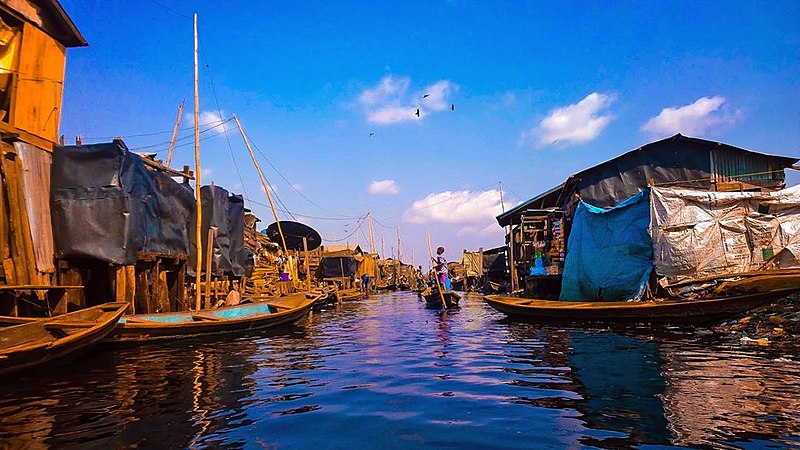Lagos, Africa’s fastest-growing megacity, has long been struggling with a severe housing crisis. The situation is especially critical in areas like Makoko Waterside, a unique floating slum where the lack of affordable housing forces residents into substandard living conditions. A two-room wooden shanty, without basic amenities like toilets or bathrooms, can cost up to N180,000 annually—a reflection of how dire the housing problem has become.
Makoko is one of Lagos’ oldest informal settlements, with an estimated 250,000 to 300,000 people residing in the area, although some reports suggest the population could be as high as 400,000. This densely populated slum has evolved from a fishing village into a sprawling maze of wooden houses built on stilts over the Lagos Lagoon, serving as home to generations of Egun fishermen since the 19th century.
A Glimpse Into Makoko: Life on Water
Traveling through the Makoko Waterside, one quickly realizes the magnitude of the housing problem. As described in the original Nairametrics article, a young man guides his canoe between makeshift homes perched on wooden stilts. Here, life happens on the water—women sell fish from canoes, and children navigate their way through the watery streets. But beneath the seemingly bustling community lies the grim reality of extreme poverty.
There are no proper flats or houses in Makoko. Instead, residents occupy one- or two-room wooden structures with limited access to shared facilities. Residents must pay as much as N100 to use public toilets and bathing facilities, further complicating their already difficult financial situations.
According to Chief Victor Panke, the Baale of the Adogbo 1 community, the area has been home to generations of Egun fishermen since the 19th century. Yet, despite its deep-rooted history, Makoko remains a place where basic services like water, sanitation, and electricity are absent.

The High Cost of Living in Shanties
Despite the poor living conditions, the cost of housing in Makoko has steadily increased, reflecting the housing deficit in Lagos.
For Monday Isaiah, a construction company driver, Makoko has become a reluctant refuge. He explains that the rent for a single room in Makoko is now N60,000 annually, while a two-room wooden structure costs N180,000 per year. Residents like Isaiah are also required to pay three years’ rent upfront, in addition to agent fees and other costs that total between N100,000 and N150,000.
This trend isn’t isolated to Makoko. Other shanty settlements along the Lekki-Epe Expressway, such as Mobil Road near Ajah, experience similar conditions, where people pay for makeshift homes that offer little protection or comfort. This situation mirrors a broader reality, as families continue to seek shelter in uncompleted buildings due to unaffordable rent in formal housing markets.
Lagos’ Housing Deficit: The Bigger Picture
The housing crisis extends far beyond informal settlements like Makoko. Lagos, a city with over 20 million people, faces a housing deficit that affects all social classes. According to a report by PwC, approximately 75% of Nigeria’s 42 million housing units are substandard, and Lagos is at the center of this crisis.
Efforts by the Federal Government and the Lagos State Government to tackle the issue, such as the Renewed Hope Cities and Estates program, aim to build 50,000 housing units across Nigeria. However, the estimated investment required to solve the housing deficit is a staggering N5.5 trillion over the next ten years.
Government Interventions and Slum Upgrading Efforts
To address these challenges, the Federal Government has introduced urban renewal projects and slum upgrading initiatives. Arc. Ahmed Musa Dangiwa, Minister of Housing and Urban Development, stated that Nigeria needs to build 550,000 housing units annually to meet the country’s growing demand. In addition to the N500 billion annual allocation requested from the Senate, the government is implementing the Renewed Hope Cities and Estates program, which aims to construct 1,000 housing units per state across Nigeria’s six geopolitical zones.
Additionally, the Lagos State Government has intensified its efforts to demolish illegal structures and shanties across the state. In areas like Apongbon, Dolphin Estate, and Ikoyi Towers, demolitions have begun as part of a broader effort to create a cleaner and safer urban environment.
However, experts like Engr. Babatunji Adegike, General Secretary of the Nigerian Institution of Civil Engineers, warn that demolishing shanties without providing affordable housing alternatives is not a sustainable solution. Adegike emphasizes that unregulated buildings not only disrupt urban planning but also pose health and safety risks.
The Way Forward: A Call for Collaboration
Lagos’ housing crisis requires more than short-term fixes. Collaborative efforts between government bodies, civil engineers, and private stakeholders are essential to create a sustainable housing model that meets the needs of its growing population. The success of initiatives like the Renewed Hope Cities and Estates program will depend on adequate funding and public awareness campaigns to ensure that residents are informed and engaged in the process.
As Lagos continues to grow, it’s vital that housing policies reflect the realities faced by lower-income families, ensuring that affordable housing is not just a dream but a reality for all.
For the original article and in-depth insights into the Lagos housing crisis, visit Nairametrics here.




